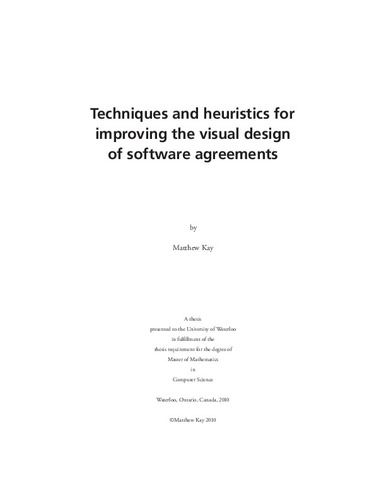| dc.description.abstract | End users must regularly agree to lengthy software agreements prior to installing software or using software services. However, despite the fact that these agreements contain terms of direct concern to users—e.g., data collection policies—software agreements are typically read by less than 2% of the population [30]. This thesis presents techniques and heuristics for improving the presentation and visual design of software agreements, to better capture reader attention and improve comprehension. In contrast to other techniques, these techniques are applied to the full agreement content, rather than a summary, as summaries have been found to distract readers from the full content of the agreement [44,56].
This thesis introduces two techniques for improving software agreements: narrative pictograms and textured agreements. Narrative pictograms are a pictorial technique designed to improve the communication of agreement terms to non-native readers of the language of an agreement. An experimental study shows that they can successfully communicate the basic concepts of a data collection policy without words. Textured agreements are visually redesigned software agreements that highlight information relevant to users. A pair of experimental studies shows that they increase both reading time—by 30 seconds, from 7 in the first experiment and 20 in the second—and comprehension of agreement content—by 4/16 points, from 0.
Finally, a solid understanding of users’ attitudes towards specific agreement content is needed to inform the design of improved software agreements. To that end, this thesis presents an analysis of EULAscan, an online community of anonymous reviewers of software agreements. An open coding is used to categorize 191 EULAscan reviews. From this analysis, functionality emerges as the most prevalent concern. The wide variety of other concerns across reviews suggests that static designs of software agreements would inadequately serve a large population of users. Instead, this thesis proposes a focus on end-user tools that identify and highlight clauses of possible interest to a given user—for example, terms that the user has not seen before. | en |

